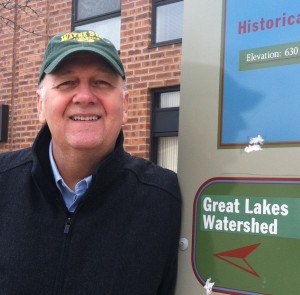
Gary Wilson
Commentary
Sometimes to go forward it helps to look back.
Here’s an example.
In 2005, the Washington Post introduced an article about efforts to get Great Lakes restoration moving with this sentence:
“Sea of studies doesn’t help restoration of Great Lakes.”
The article’s essence was that the lakes had been studied ad nauseum. Now it was time for action.
The Post referenced a General Accounting Office report that said ….”years of studies and committees have not resulted in significant restoration.”
Indeed, that became the mantra of advocates for restoration. The time for study was in the past and it was now time to fund and implement an action plan.
Fast forward to last week when two news stories caught my eye.
The Great Lakes Environmental Research Laboratory announced a major study of Lake Huron and said it was the “least studied of all the Great Lakes,” according to a Great Lakes Echo report.
And Michigan Tech University announced the opening of a new $25 million Great Lakes Research Center.
The facility’s director, Michael Abbott, told the Detroit News that “this is a place where, finally, we can bring people together who are interested in research relating not only to Lake Superior but all of the Great Lakes…”
These news reports caused me to reflect. Don’t we already have a lot of studies in process? And it seems that we have plenty of research entities.
I decided to give myself a little test. How many current Great Lakes studies and research facilities could I quickly list, without a Google search.
Studies — there’s one on upper Great Lakes water levels, two on separating the lakes from the Mississippi River, a Canadian Asian carp study, a wetlands study, a plastics in the lakes study and one on coastal flooding.
Research facilities — University of Wisconsin- Milwaukee has one as do Ohio State University, Grand Valley State University, Central Michigan University, the previously mentioned Great Lakes Environmental Research Lab and Michigan Tech’s newly minted venture. Toss in the International Association for Great Lakes Research in Ann Arbor and the work that the USEPA and the International Joint Commission do and yes, we have research entities.
Remember, this was off the top of my head and I’m not in the field.
The more important question is how the well-being of the Great Lakes is served by this scientific community and its work.
Are there too many studies? Are they focused on the most pressing issues or are they science for the sake of science? Will they help policy makers and on the ground managers make informed decisions that lead to results? Or should scientists be left to their work without interference from external interests?
Big questions, so I contacted two experts from different disciplines for their thoughts. A surprisingly quick consensus emerged.
“Our science has been good at telling us the state of the Great Lakes ecosystem” said Cameron Davis, the Obama administration’s senior adviser for the Great Lakes. “But we need to push our science to do more, faster and better, including giving our policy makers more time to react.”
Davis said that Great Lakes science needs to be more predictive which will help managers develop preventive strategies.
Patrick Doran from the Nature Conservancy echoed Davis’ sentiments on the need for science to be more predictive and went further.
He cited the need for the research community to improve on what he calls “the continuity of conservation.” That is “integrating scientists with managers who have to deliver on the ground results,” Doran said.
He said there are “disconnects all along the conservation continuum” and recommended that scientists ask themselves “what is our goal” before launching into a project. Doran is the Conservancy’s director of conservation for Michigan.
Where does that leave us?
Striking a balance between letting scientists work unfettered by external influences yet having the work be relevant for policy makers and managers is tricky. And both are beholden to their funding sources because nothing happens without money. And those funders may have their own agendas.
Part of Davis’ job is to demonstrate to a budget-conscious Congress that the money it appropriates will lead to results. They won’t spend limited taxpayer dollars for more study, measuring or monitoring and have made that clear.
It causes me to pause when I see policy makers trying to influence scientific priorities. That can open the door to unwarranted compromises if not carefully managed.
But we now have a system where the Great Lakes research community’s work is only helpful at the margins for policy makers and managers, the people who need it most.
The Obama administration’s Davis says if scientists want to help the Great Lakes they need to communicate to wider audiences and make their case to disciplines like law and economics.
The Great Lakes restoration community has prided itself on collaboration over the past 10 years. But collaboration seems to be in the background within the Great Lakes research community and externally with policy makers and managers.
It would be beneficial for the lakes for those groups to find a way to work together – to understand the each other’s issues. We don’t want Great Lakes restoration to drown in a “sea of studies” that don’t lead to measurable results.
